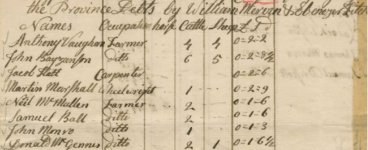Armchair detective
Full Member
- May 21, 2024
- 134
- 33
- Thread starter
- #21
The first obvious question is "Where did the lumber go?"
The poll tax records are about ownership of property, not residency. If memory serves there was a census 1797? listing one cabbage farmer for all oak island.
Miscellaneous factoid: the names you mentioned don't appear to have any connection to ownership of any plots on OI.
Do you suppose the sawpit output was destined for the Lunenburg shipyard?
Was it in operation at the time?
The poll tax records are about ownership of property, not residency. If memory serves there was a census 1797? listing one cabbage farmer for all oak island.
Miscellaneous factoid: the names you mentioned don't appear to have any connection to ownership of any plots on OI.
Do you suppose the sawpit output was destined for the Lunenburg shipyard?
Was it in operation at the time?





